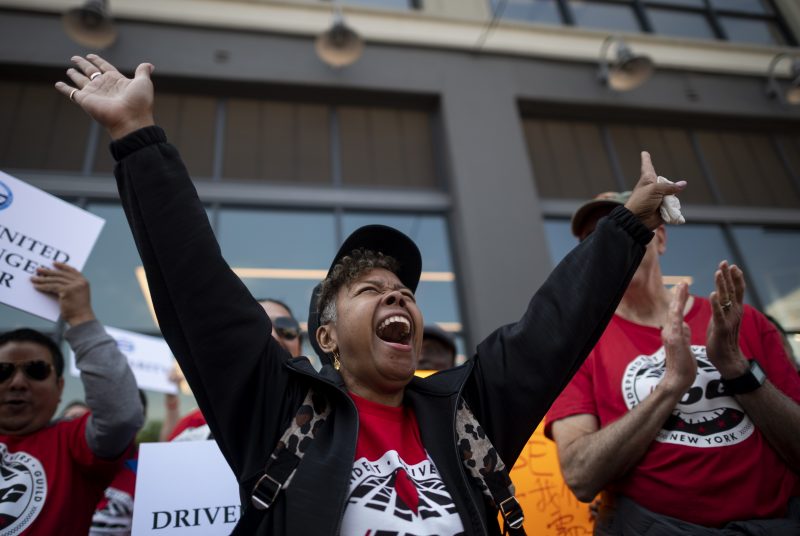Uber, Lyft drivers strike to press demands on rideshare firms
Members of the Independent Drivers Guild rallied at Uber and Lyft headquarters in New York as part of a protest to press demands for better pay and working conditions for the independent contractors (Johannes EISELE)
New York (AFP) – Thousands of Uber and Lyft drivers turned off their apps Wednesday in a series of job actions across US cities protesting pay and working conditions at the big ride-hailing services.
An estimated 10,000 New York drivers heeded a strike call, according to the New York Taxi Workers Alliance, an organizer of the action.
Around 100 people joined a protest outside a Queens building with New York offices of both Uber and Lyft, some carrying signs reading “Hard work = Fair pay” or “Solidarity.”
A separate group protested outside the New York Stock Exchange, where Uber is set to list shares, some signs reading “Invest in our lives — Not their stocks” while some drove in a procession across the Brooklyn Bridge with protest signs on their vehicles.
Similar actions were being held in Boston, Chicago, Los Angeles, San Diego and Washington.
The demonstrations come weeks after Lyft made its Wall Street debut and days ahead of a massive share offering from Uber that will give the global leader an estimated valuation of $90 billion.
The drivers are protesting arbitrary “deactivations” or firing and a shifting revenue-sharing model that critics say leaves drivers behind.
Cesar Guerrero, a 57-year-old Uber driver who attended the Queens rally, said the platform is taking advantage of its drivers.
“I don’t think the drivers are taking a fair share of the profits that are big in corporations like Uber and other apps,” Guerrero said.
Some drivers said much of the money they take in is eaten up by expenses.
“If it was not for the drivers all around the country, they would not be going public,” said Uber driver Kevin Killilea.
The alliance said it called the actions “to shine light on how Uber and Lyft’s flawed business model pushes hard-working drivers across the US and the globe into poverty and desperation.”
– Business model questioned –
With the big ride-hailing businesses outlining their path to profitability, protesters claim the ride-hailing business model, which is based on the use of independent contractors, forces drivers to absorb costs to the benefit of the platforms.
“Uber unabashedly states that denying workers of basic employment protections like minimum wage, Social Security contributions and other benefits is essential to their business model,” the New York alliance said in a statement.
The companies maintain that drivers are able to thrive and maintain work flexibility, and that their business model would not work if drivers were treated as wage-based employees.
Protests were being held in Britain as well with drivers in London, Birmingham, Nottingham and Glasgow called on to log off apps and protest outside Uber offices in each city, according to the Independent Workers’ Union of Great Britain.
Uber and Lyft did not immediately comment on the job actions, and it was unclear if the stoppages had a significant impact on their networks.
Uber said that drivers have earned over $78 billion on the platform since 2015, as well as $1.2 billion in tips since the feature was introduced in 2017.
Lyft said it has paid some $10 billion to drivers in the past two years, and that the average earnings amount to more than $20 per hour.
A number of studies contend drivers take home far less than the platforms claim after accounting for fuel, insurance and other expenses.
The Economic Policy Institute, a left-leaning think tank, concluded that Uber drivers earned the equivalent of $9.21 in hourly wages, after accounting for commissions and fees and vehicle expenses, and taking into account the health insurance and other benefits earned by employees.
Syracuse University professor Austin Zwick, who has researched ridesharing platforms, said the job actions are an attempt to shift the balance of power between drivers and platforms, which now have the power to arbitrarily determine compensation and benefits.
“The joint strike plus boycott strategy appear unlikely to succeed nationally as it does not appear that all drivers and passengers are unified behind the cause,” Zwick said.
“However, this strategy does raise public awareness and begins to build political support to pass local and state regulations. Additionally, ridesharing companies may make changes in certain markets to continue to retain drivers to work on the platform.”
As a result, Zwick said, “ultimately, your Uber ride will probably be a little bit pricier in the future.”
Disclaimer: Validity of the above story is for 7 Days from original date of publishing. Source: AFP.


